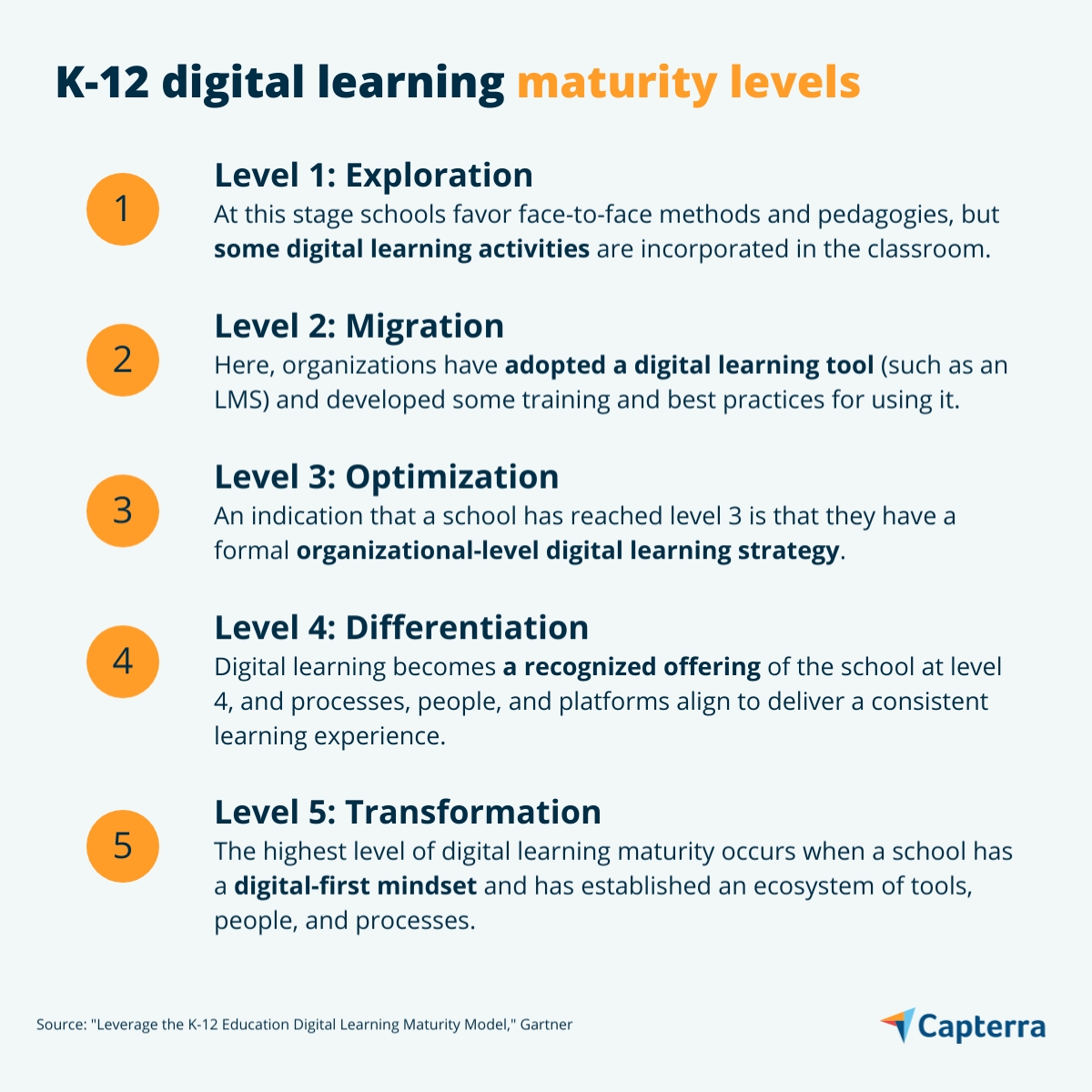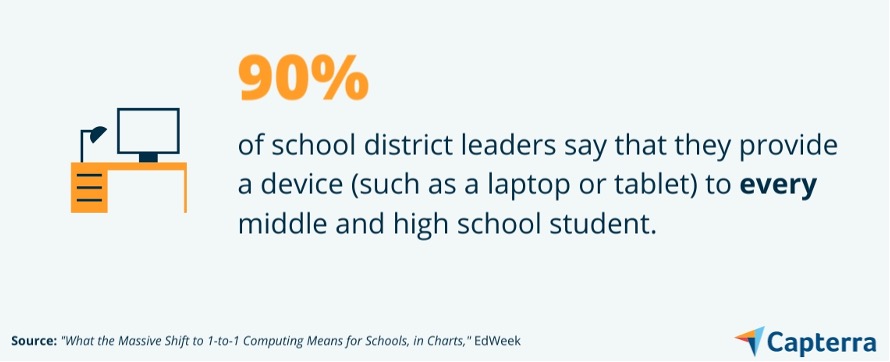For technology to be effective in the classroom, digital maturity is essential.
In 2020, a forced shift occurred in the K-12 educational system. Unable to meet in-person, students logged on to class from home, and teachers used webcams and eLearning platforms to deliver lessons. And while the digital transformation it took to make this happen was at times involuntary, that didn’t take away from the fact that there were benefits to the shift.
According to Gartner, the majority of teachers (57%), principals (65%), and administrators (73%) think digital learning tools are more effective than non-digital tools for personalizing instruction, and all three educator groups also say they are more effective for engaging students with school and learning[1].
If you’re an administrator who’s ready to achieve greater digital maturity at your school in order to deliver personalized, engaging lessons to students, we’re here to help provide you with information you need to support your efforts. Packed with research from Gartner, this content will explore the topic of digital maturity and how it relates to three educational frameworks: in-person, hybrid, and remote learning.
Let’s start with the basics: What is digital maturity?
Digital maturity is a term used to describe an organization’s ability to create value through technology, but because technology is constantly evolving, digital maturity is not something you can achieve and move on from—instead, it is an ongoing commitment.
In the context of K-12 education, digital maturity can be thought of as digital learning maturity. Whether student learning takes place in-person, remotely, or in a hybrid environment, the use of digital resources and methods contribute to a school’s digital learning maturity.
What are the levels of digital maturity, and how do you determine where your organization falls?
To achieve the highest level of digital maturity, administrators must work with teachers and IT staff to align tech investments (such as learning management systems and collaboration tools) with their school’s instructional strategy, all while keeping their highest priorities (curriculum and otherwise) in mind.
Gartner’s K-12 Education Digital Learning Maturity Model[1] breaks down five different levels of digital learning maturity in schools:

For a more in-depth look at each level and indicators that will help you determine where your school currently lands on the spectrum, download the full K-12 Education Digital Learning Maturity Model.
You can use this model to determine where your school’s digital learning strategy currently stands. Do this by comparing your digital learning methods, tech investments, and how involved school staff are in digital learning initiatives to the indicators documented at each level in the table.
How does digital maturity support in-person, hybrid, and remote learning?
Armed with the knowledge of your school’s current digital learning maturity level, you may be wondering: Does digital maturity even matter if my school is using a fully in-person educational framework? The short answer is yes, but we’ll dive deeper into why below.
According to a survey conducted by EdWeek Research Center in 2021[2], the majority of elementary, middle, and high school districts are embracing a one-to-one computing model, regardless of their educational framework:

What is one-to-one computing?
In schools, one-to-one computing means that each enrolled student is assigned an electronic device, such as a laptop or tablet, in order to access the internet, digital course materials, and digital textbooks.
Despite this widespread adoption of one-to-one computing (or perhaps because of it) in K-12 schools, district leaders report facing challenges when it comes to delivering digital learning. Among the challenges they reported, these were the top five:
Students are distracted by having access to the internet and other applications (60%)
Parents struggle to help students use technology at home (59%)
Concerns about student screen time (56%)
Insufficient internet connectivity at home (53%)
Teacher tech fatigue (52%)
The good news is that many (though not all) of these challenges can be alleviated by evolving your school’s digital learning strategy.
For instance, Gartner suggests that at a digital maturity level of three, your faculty’s digital learning capabilities should be developed through formal training programs and access to a pool of digital pedagogical resources—both of which would greatly help alleviate teacher tech fatigue. At level five, parent engagement is considered a sign of success; meaning, parents would take an active role in ensuring their child is leveraging the technology available to them. Also at level five, digital learning becomes such an integral part of a school’s offering that it no longer needs to be referred to as “digital”—it’s just learning.
All this to say, if your school is a part of the majority that are providing students with their own devices to learn, failing to work toward digital learning maturity is the same as settling for disengaged students, staff, and parents.
Next, we’ll take a look at how digital maturity relates to each educational framework individually and provide tips that will help you and other school leaders take steps to evolve your strategy.
Make in-person learning more engaging with an LMS
Capterra’s Education LMS User Research Survey* polled learning management system (LMS) users from K-12 schools in order to understand the primary use cases for their education technology and whether the results of their investment were in line with their expected outcomes.
When asked about the impact these systems had on factors such as student engagement and teacher/admin productivity, the results were overwhelmingly positive:

Considering that Gartner’s K-12 Education Digital Learning Maturity Model uses the example of adopting an LMS as a sure sign a school is at a level two, organizations that plan to prioritize in-person learning should aim to reach this level in order to take advantage of the benefits these systems provide.
How to achieve level 2 digital learning maturity:
Whether you already have an LMS or you’re looking to adopt one for the first time, following the tips below will help you avoid buyer’s remorse when selecting a platform for your school.
Evaluate your school’s tech budget: First, determine what kind of funds your organization has for new education technology investments. This will help you focus on software vendors and plans that are within your budget during the selection process.
Demo tools: Next, spend some time demoing different LMS platforms. This will help you understand what kind of features your school would most benefit from. Make sure that other administrators, IT staff, and teachers are involved in this step.
/ Related reading
Adopt an LMS: It sounds straightforward, but choosing an LMS and successfully rolling it out to administrators, teachers, and learners is a complicated undertaking. For help figuring out which product you demoed is the best fit for your school, use our software comparison tool. Then, after choosing a system, ask your vendor if they offer any initial training sessions. If so, set up a time for them to walk the admins and teachers at your school through using key features of the platform for a smooth adoption.
Develop best practices for creating digital instructional materials: Lastly, once you have an LMS, you’ll need to develop best practices for using it for teachers and administrators. For example, will each teacher take attendance through the system? Will quizzes and tests all be conducted digitally, but in-person? Work with department heads at your school to come up with a standard set of practices for using the LMS that will lead to the most effective teaching.
Create a remote learning experience on par with in-person instruction
Hybrid learning environments combine in-person and virtual instruction. What this looks like in practice varies from school to school; most commonly, classes occur in person but are live streamed to a handful of students who are attending remotely. However, in some cases classes may be held entirely online or in person depending on the day and learning activity the teacher has planned.
If you’ve committed to a hybrid instructional framework for the foreseeable future, you need to ensure that the learning experience your teachers are providing is of the same quality, whether it’s in person or virtual. Doing this requires investing in the virtual learning experience at your school, which is in line with the core aspects of level three of Gartner’s K-12 Education Digital Learning Maturity Model.
At level three, schools complement their LMS with additional systems such as video conferencing software and content management systems—both of which are essential for connecting with remote learners and ensuring they have access to the resources they need to be successful. Further, teachers become more committed to digital learning at level three, increasing their ownership in the process and strengthening the quality of what’s being delivered to students. From this, we can assume that any organizations who intend to carry on with a hybrid curriculum framework should aim to have a digital learning maturity level of three or higher.
How to achieve level 3 digital learning maturity:
Faculty adoption and involvement in the organization’s digital learning strategy is essential to achieving level three, which is why the to-do’s below are centered around these ideas.
Develop a formal digital learning strategy: Hybrid learning models require remote instruction at times, so it is imperative to develop a digital learning strategy. This is easier said than done, but to get started, set up a time to meet with department leads, IT staff, and your school’s superintendent. Use this time to determine what kind of tools will be used to deliver remote learning (and whether new software purchases need to be made), as well what the ideal mix of in-person and virtual learning looks like for your school. Further, make sure that your IT counterparts are prepared to set up classrooms for virtual learning delivery and that you have a system for submitting tech support tickets.
Prioritize software investments that help administrators and teachers: When it comes time to evaluate which kinds of software tools will best support hybrid learning, keep your faculty’s priorities top of mind. For example, which platforms would help lessen the workload of your teachers or save them time? Overcomplicating your faculty’s roles could drive them away in a time where there’s a teacher shortage[3].
Create a communication strategy for updating students and parents: Lastly, you’ll need to determine who within your organization will be responsible for informing students and parents about new policies and platforms. Getting parents onboard with virtual learning requires their understanding of how your school is delivering virtual instruction and their expected involvement (if any).
Make virtual learning a recognized offering of your remote-first school
For schools that embrace a remote-first approach to learning, the need to achieve a high level of digital maturity is indisputable. This is evident from the quality of remote learning experiences that schools provided back in 2020 when they were forced to close down their physical locations due to the COVID-19 pandemic. As Rutgers puts it, the rollout of remote learning at the time was “...haphazard, under-resourced, and inequitably delivered”—especially in low-income areas[4].
It takes time, resources, and planning to deliver a high-quality remote learning experience, which is why many schools failed to do so in 2020. But if your organization is committed to a remote-first educational framework, working toward digital maturity will put you on the path to become a recognized leader in K-12 digital learning.
How to achieve level 4 digital learning maturity:
Digital learning becomes a core offering at the school at level four of Gartner’s K-12 Education Digital Learning Maturity Model. If your school has decided to prioritize remote instruction over in-person learning, working toward level four will ensure success.
Create a knowledge base: Having a hub where resources such as process documents and best practices are centralized makes it easier for teachers and administrators to find the answers they’re looking for in a pinch. Some learning management systems are built to house resources such as these, or you can invest in a separate knowledge base platform.
Start using data to personalize learning: As stated at the top of this article, being able to offer more personalized learning to students is one of the main advantages of digital learning. For instance, teachers can easily access information related to their students’ performance and habits within their LMS; all that’s left to do is use this information to tailor their instruction to student needs and preferences. For example, if your LMS shows that students are accessing video content more often than text-heavy PDFs, teachers can respond by prioritizing video content in their courses going forward.
Standardize, but leave room for improvement: Standardization is a sign of a digitally mature organization. Using the same tools and processes across departments will help ensure that 1) students know what to expect from each class and can fall into a routine, and 2) teachers can rely on one another for support when it comes to creating and delivering virtual learning content. Ideally, your school will reach a point where the digital learning experience is standardized across departments, while still leaving room for improvements or innovation.
Final recap: Work toward your school’s ideal level of digital maturity to reap the benefits of virtual learning
In one form or another, technology has been used in K-12 classrooms for learning activities for nearly 70 years. It’s high time for schools to recognize the value of having a strategy behind their digital learning initiatives—whether they operate primarily in-person or online.
In this guide, we’ve covered what administrators need to know about digital maturity and how to take their organization to the next level. To recap, here are your next steps:
Download our K-12 Education Digital Learning Maturity Model to determine what level your school is currently at.
Figure out which level your school should ideally be at based on the educational framework you’ve adopted.
Use the steps outlined in the sections above to move your school toward its intended level of digital maturity.
Looking for more content related to educational technology? Start here: Resources about Education Technology to Help You Succeed

